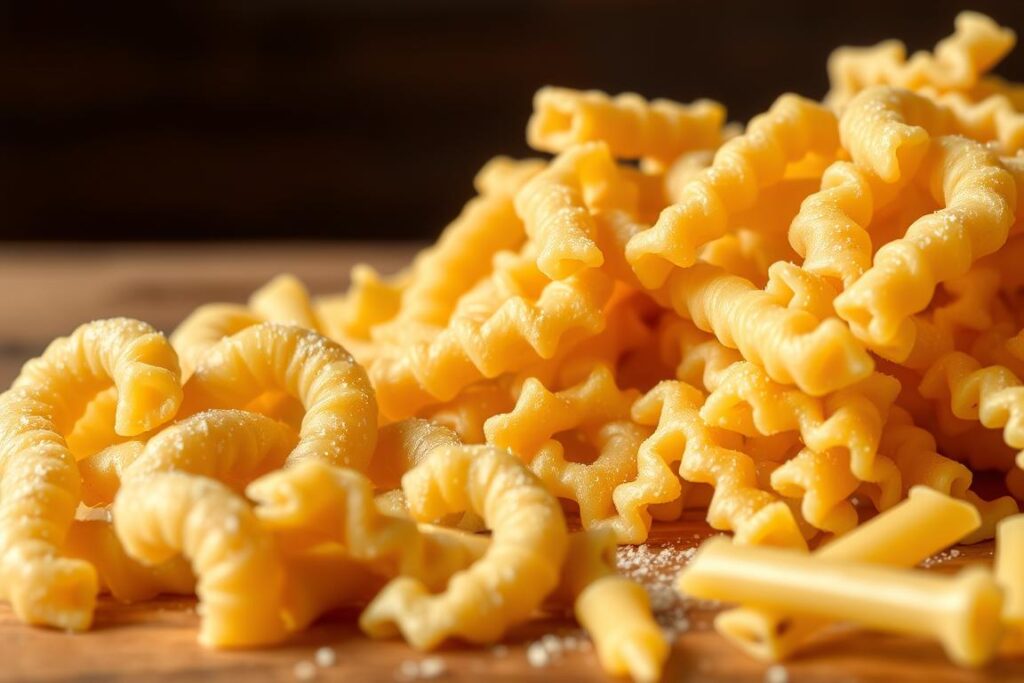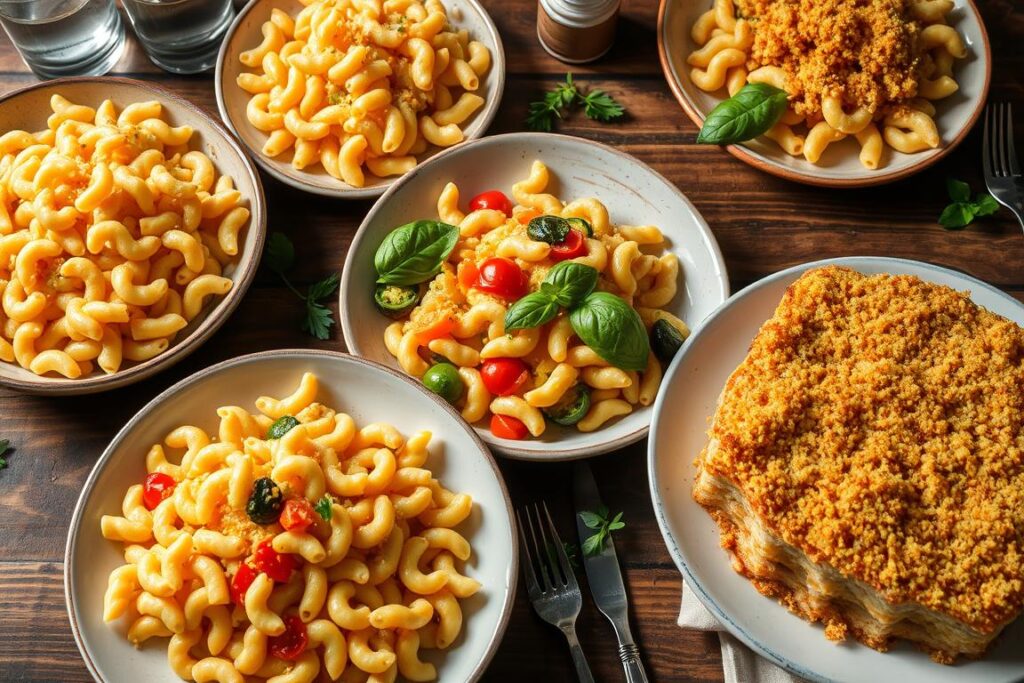Ever wondered why elbow pasta is called something fancy? This shape, known for its unique curve, is more than just a simple ingredient. It’s a key part of many dishes, especially macaroni and cheese. Let’s explore the fancy name for elbow pasta and why it’s special in different cuisines.
Key Takeaways
- Elbow pasta is commonly referred to as macaroni.
- In Italian, elbow pasta is known as “maccheroni.”
- This pasta shape is versatile and loved in many dishes.
- The term “maccheroni” encompasses a variety of pasta types in Italy.
- Understanding pasta names enriches culinary appreciation.
The Origin of Elbow Pasta
The story of elbow pasta is deeply rooted in Italian traditions. Known as “maccheroni,” it’s loved all over the world, especially in America. The name comes from the Greek word “makaria,” which was part of a barley broth served at feasts for the dead. This shows how pasta is more than just food; it’s a symbol of culture.
Elbow macaroni is a staple in many American homes, often found in comfort foods like macaroni and cheese. But its history goes back to the Mediterranean, where pasta is a key part of family and social events. It’s not just food; it’s a way to connect with others.
Learning about elbow pasta’s origins helps us value its place in Italian cuisine. Its shape is perfect for holding sauces, showing the Italian way of blending flavors and textures. Even as it changes in kitchens around the world, its roots stay strong in history.
| Aspect | Details |
|---|---|
| Term | Maccheroni |
| Language Origin | Derived from Greek “makaria” |
| Cultural Significance | Celebration of feasts |
| Popular Usage | Macaroni and cheese in American cuisine |
| Italian Context | Integral part of traditional meals |
Understanding Tubular Pasta Types
Tubular pasta includes many pasta shapes perfect for different dishes. Macaroni shapes, like elbow pasta, are famous for their unique curve. This shape helps them hold onto sauces better, making them great for comforting meals.
Here are some common tubular pasta types:
- Penne
- Rigatoni
- Ziti
- Fusilli
- Macaroni
Each pasta shape has its own texture and surface area. This affects how they work with sauces. For example, rigatoni’s ridges are great for chunky sauces. Ziti’s smooth surface is perfect for creamy sauces.
Macaroni shapes, especially elbow macaroni, are key in many kitchens. They’re often used in baked dishes and creamy sauces. Knowing about tubular pasta types helps in choosing the right one for your recipe.
The Different Names for Elbow Pasta
Elbow pasta is known by many names, especially in Italian cooking. One common term is gomiti, which means “elbow” in Italian. This name comes from the pasta’s bent shape, like a person’s elbow. In different places and cooking styles, other names may be used.
Another name for elbow pasta is maccheroni. While some people use these names together, there’s often a difference based on where you are or the type of pasta.
Looking at pasta names more broadly, elbow pasta can be confused with other tubular noodles. For example, it’s often compared to lumache or lumachine, which look like small snail shells. This shows how different names for elbow pasta can mean different shapes and sizes, adding to the variety in cooking.

Learning about these names helps us appreciate Italian food more. It also lets us explore different recipes and flavors from various regions.
| Name | Translation/Description |
|---|---|
| Gomiti | Elbow; refers to the curved shape of the pasta |
| Maccheroni | A broader term, often highlighting various pasta shapes including elbow |
| Lumache | Snail-shaped pasta, often compared to elbow styles |
| Lumachine | Similar to lumache but smaller in size |
What is the fancy name for elbow pasta?
Elbow pasta is known by many names, each with its own cultural significance. In Italian, the fancy name is maccheroni. This term covers a range of short, tubular pasta shapes. In America, it’s mainly linked to the well-known elbow macaroni.
Maccheroni
In Italy, maccheroni can mean any short pasta shape. It’s key in many dishes, adding flavor and texture. This shows how macaroni fits into different cultures, making it great for baked ziti and pasta salads.
Gomiti
Gomiti means “elbows” in Italian. It’s a clear term for the elbow-shaped pasta in both Italian and American contexts. Knowing these terms helps us appreciate pasta’s cultural value. It shows how language enriches our culinary experiences.
Variations of Elbow Macaroni in Italian Cuisine
In Italian cooking, elbow macaroni is a star with many uses. It’s often found in baked casseroles, making meals warm and perfect for family. These dishes mix cheese with elbow macaroni, creating a tasty treat. This dish stands out from the usual American macaroni and cheese.
Italian chefs often prefer other pasta shapes like penne or rigatoni for certain recipes. They like these shapes for their texture, which is different from elbow macaroni. These shapes work great with rich sauces and fresh ingredients in classic Italian dishes.
Some top recipes that show off maccheroni’s versatility include:
- Maccheroni al Forno – a traditional baked dish with cheese, meats, and béchamel sauce.
- Pasta al Pomodoro – a simple yet flavorful dish emphasizing fresh tomatoes and basil, where elbow pasta adapts beautifully.
- Insalata di Pasta – a cold pasta salad featuring seasonal vegetables and robust dressings, showcasing versatility in summer dishes.
Knowing these variations helps cooks pick the right pasta for their recipes. For more info on other pasta shapes and their uses, check out this comparison of penne and ziti.
Global Popularity of Elbow Macaroni
Elbow macaroni is a favorite worldwide, especially in the United States. It’s a key ingredient in the beloved macaroni and cheese. This pasta is loved globally, influencing food traditions everywhere.
Mac and Cheese in America
Macaroni and cheese is a comfort food staple in the U.S. It’s made from scratch or from a box, loved by all ages. Its creamy and cheesy taste makes it a classic favorite.
International Uses of Elbow Pasta
Elbow macaroni started in Italy but has spread worldwide. Switzerland and Great Britain have made their own versions, mixing new flavors and techniques. In places like Hong Kong, Malaysia, and Singapore, it’s part of local pasta dishes, showing its global appeal.
| Country | Signature Dish | Description |
|---|---|---|
| United States | Mac and Cheese | A creamy combination of elbow macaroni and cheddar cheese, often a childhood favorite. |
| Switzerland | Älplermagronen | A comfort dish that blends pasta with potatoes, cream, onions, and cheese, served traditionally. |
| Great Britain | Cheesy Pasta Bake | Elbow macaroni baked with cheese and often topped with breadcrumbs for added crunch. |
| Hong Kong | Pasta with Tomato Sauce | Elbow macaroni served with a rich tomato sauce, often including local spices. |
| Malaysia | Macaroni Goreng | A stir-fried version with chili and local vegetables, giving a spicy twist to traditional pasta. |
Pasta Nomenclature: The Terms Explained
Learning about pasta nomenclature is key for anyone who loves cooking. The many terms for types of pasta can be confusing, especially since they differ across languages and cultures. Each pasta shape, like rigatoni, penne, or macaroni, has unique traits that guide how it’s used in cooking. For example, “macaroni” often means different shapes.
Also, culinary terms can show us how pasta has been used over time. Knowing these terms helps cooks pick the right pasta for their meals, making them taste better. Getting to know the basics of macaroni terminology can change how we cook. It makes dishes better and respects their cultural roots.
To understand the differences between popular pasta shapes, like penne and rigatoni, check out this article. It explains their uses and how to use them in recipes. By exploring pasta nomenclature, cooks can see the rich traditions behind these foods.
Similar Pasta Shapes in Italian Cuisine
Elbow pasta is part of a group of shapes that each add something special to dishes. Shapes like chifferi, lumache, pipe, and pipette show the variety in Italian food. They work well with different ingredients and sauces.
Chifferi and Lumache
Chifferi looks a lot like elbow pasta but is shaped like a crescent. It’s great for holding onto sauces, making it perfect for rich or creamy dishes. Lumache has a snail-like shape that catches meat or veggies nicely. Both shapes make meals fun and can make any dish better.
Pipe and Pipette
Pipe and pipette are both tubular shapes that are great for thick sauces. Pipe is a bit bigger than elbow pasta, ideal for a big sauce base. Pipette is smaller and fits well in soups or casseroles. These shapes are versatile and important in many kitchens around the world.
Culinary Applications of Elbow Pasta
Elbow pasta is known for its unique curved shape. It’s a key player in American cooking. It’s especially loved for its role in mac and cheese, where it holds creamy sauces perfectly. This makes it a comfort food favorite.
But elbow pasta is not just for mac and cheese. It’s great in pasta salads too. It pairs well with many dressings and ingredients like veggies, meats, and cheeses. In casseroles, it becomes a staple, allowing for creative recipes that please the whole family. Its shape helps sauces stick, making every bite flavorful.
Looking closer at elbow pasta’s uses, we see its wide appeal. It’s perfect for bold flavors and light dishes alike. It’s a must-have for home cooks. Here are some popular recipes that show off elbow pasta’s versatility:
| Recipe Type | Main Ingredients | Flavor Profile |
|---|---|---|
| Mac and Cheese | Cheddar cheese, milk, butter | Rich, creamy |
| Pasta Salad | Vegetables, Italian dressing, olives | Fresh, tangy |
| Elbow Pasta Bake | Ground beef, tomato sauce, cheese | Savory, hearty |
| Macaroni Salad | Mayonnaise, celery, hard-boiled eggs | Creamy, crunchy |

Elbow pasta is more than just an ingredient; it opens up a world of flavors and creativity. By trying out different recipes, you can turn simple meals into exciting culinary adventures. It’s a key ingredient that brings people together, creating lasting memories over delicious meals.
Conclusion
Elbow pasta, also known as maccheroni, is a key ingredient in both American and Italian cooking. Its unique shape makes it versatile for many dishes. This shows its importance in different cuisines.
This simple ingredient has a long history, starting in ancient Italy. It has changed over time, adapting to new cultures and recipes. For example, the summary of maccheroni shows its evolution.
Elbow pasta is more than just food; it’s a symbol of comfort and joy. It fits well in both traditional and new recipes. This makes it a favorite in many kitchens around the world.


